
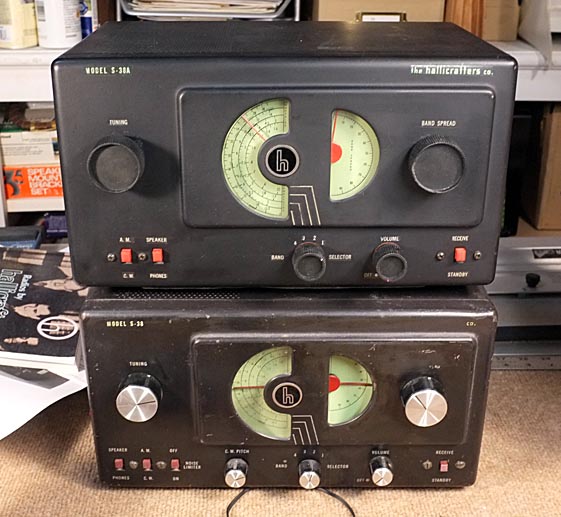
The Hallicrafters S38 series of radios are extremely popular among collectors. They are simple AC/DC radios with good performance and a striking post-war modern industrial design. I picked up a S-38 and S-38A at a ham swap for $25 for the pair.
The S-38A had been recapped, and played well. I had to recap the S-38 and replace two bad tubes. The tuning capacitor was shorted when nearly fully closed, so I had poor reception on the lower 1/4 of the dial scale. I ended up buying a junker S-38 and transplanting the tuning condensor. I made and installed new clear plastic dial covers. I installed new line cords with polarized plugs, hot side to the On/Off switch. I installed new rubber grommets to isolate the metal cabinets from the chassis on both radios. The S-38 needed a set of original knobs and the cabinet needed repainted as it was pretty beat up.

At left is the S-38 after I repainted the cabinet, applied new lettering decals from Radio Daze, and a set of original Hallicrafters knobs which I got from the junker radio. The band spread knob from the junker set was badly chipped, so I bought a reproduction knob from Renovated Radios, along with a reproduction small knob for the band selector control.
The S38 radios went through a number of design and cosmetic changes over the years. The original S38, for some, the most desirable, had a separate BFO pitch control and ANL switch. The later models did not. The S38A, S38B, and S38C retained the two half-moon dials, although there were minor differences in the paint color and finish. The S38C had a grey cabinet. The last two variants, the S38D and S38E eliminated the iconic half-moon dials in favor of a more contemporary slide rule dial.
Some believe the S-38's with the half-moon dials were designed by famed industrial designer Raymond Loewy; others adamantly insist this is not the case. Whether or not Raymond Loewy had a hand in their design, the handsome styling and good performance ensures they remain on many a collectors' bucket list.
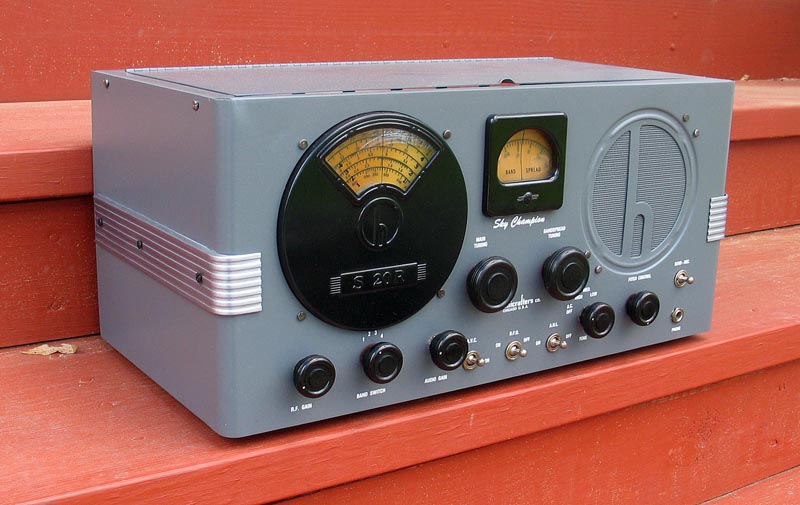
This radio belonged to a friend's grandfather. My friend was getting ready to retire and move to another state, and was getting rid of a lot of his possessions, including this radio. When I picked up the radio, I found that it was not in very good cosmetic condition. The cabinet had some rust and a good bit of wear. The radio appeared to have been dropped at some point, torquing the cabinet so that the hinged top lid didn't line up properly with the opening at the top of the cabinet.

When I pulled the chassis, I found that the radio had been partially recapped at some point in the past. Almost all the paper/wax capacitors in the radio are either .05uF or .02uF. All the .05uF caps had been replaced with Gudeman XFS caps. The workmanship was quite good, and I decided to leave them alone until I recapped the rest of the radio and tested it. I replaced the electrolytic caps and all the remaining original paper/wax caps. The radio played well, so I decided to leave the Gudeman caps in place.
I used long clamps to repair the bent top piece of the cabinet. I then sanded the cabinet down to bare metal, and applied Rustoleum primer. When that dried, I applied Rustoleum dark grey, which was a close match to the original grey. I obtained a new lettering set from Radio Daze and relettered the radio. A coat of Rustoleum clear satin finish did an excellent job of hiding the decal edges so that the lettering looks almost factory original.
Performance-wise, the nine tube S-20R is an improvement over its six tube little brother, the S-19R Sky Buddy discussed further down this page. The S-20R has an RF amplifier and RF gain control that the S-19R lacks, two stages of IF amplification, and the audio quality is better on the S-20R. I replaced the original 6F6 audio output tube with a more effecient 6V6 tube.
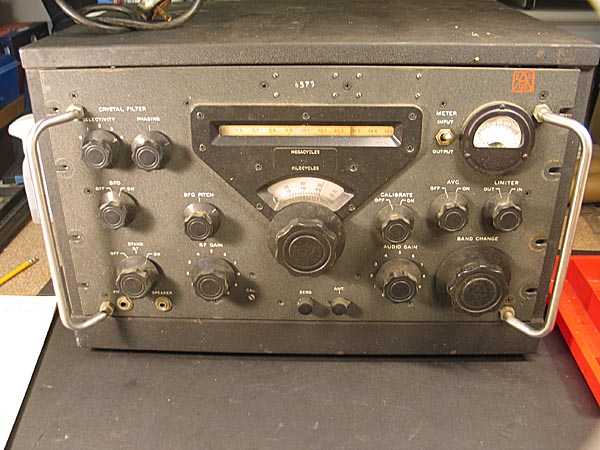
My connection to this particular radio, also known by its military designation, R-388/URR, dates back to 1957. The radio belonged to a friend my age (15 back then) who lived next door. His dad was in the USAF, and gave my friend this receiver. We used the copper screen in his window as an antenna and could pick up HAM operators and all the commercial/government shortwave that filled the airwaves back then. We have stayed in contact over the years, and he recently reminded me of this radio, which he wants to pass it along to his son, and I offered to check it out for him. He thinks the last time the radio was played was in 1961 or 1962.
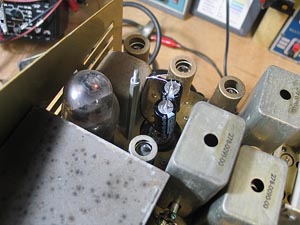 With the chassis removed from the cabinet, I checked the radio over, did some cleaning and lubing of the gear train. I removed the original filter capacitors and replaced it with a temporary set for testing. I then brought the radio up to power very slowly using a variable transformer. I was very pleased when the radio came alive!
With the chassis removed from the cabinet, I checked the radio over, did some cleaning and lubing of the gear train. I removed the original filter capacitors and replaced it with a temporary set for testing. I then brought the radio up to power very slowly using a variable transformer. I was very pleased when the radio came alive!
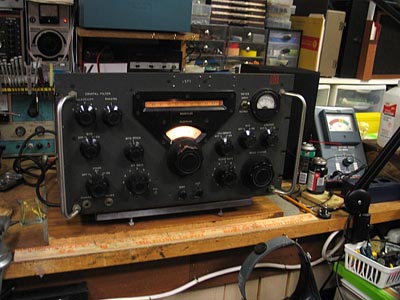 You can see and hear the Collins play at this You Tube link: Collins 51J
You can see and hear the Collins play at this You Tube link: Collins 51J
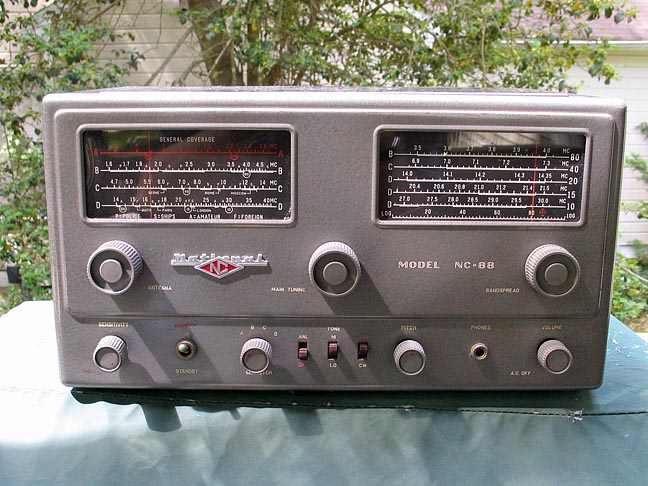
Produced from 1953 to 1956, the NC-88 was an entry-level amateur general coverage receiver. It was considered to be a decent performing radio, with a nine tube lineup, including the rectifier. The radio features an antenna trimmer, sensitivity control, ANL, AM/CW, pitch control, and a HI/LOW tone switch. The bandspread tuning, when used according to the manual directions, can be used to electronically tune each of the major amateur bands, 10 meters through 80 meters. As it predates SSB, though, unless you find some amateurs still operating on standard AM, you won't get anything but garbled traffic.
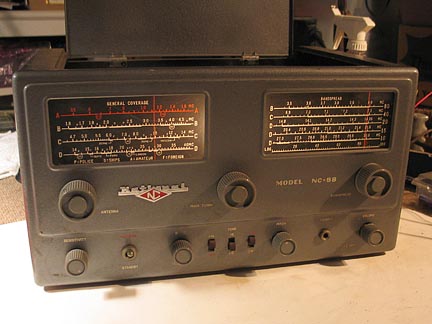 When I first got the radio home, and connected it to the Variac, the radio played for about ten minutes, then the 5Y3 rectifier tube died. I replaced it along with a bad 12AX7 and the radio played well with good volume on all bands, using a 70' long wire antenna. I was bothered by the very poor audio quality, though. The output was very tinny, even with the tone control in the LO position. I then noticed that the original National speaker had been replaced. I ran a lead to my test speaker on the workbench and the audio quality was much better, so I found a replacement speaker that would fit, with some modification to the mount, and swapped it out for a much better audio experience.
When I first got the radio home, and connected it to the Variac, the radio played for about ten minutes, then the 5Y3 rectifier tube died. I replaced it along with a bad 12AX7 and the radio played well with good volume on all bands, using a 70' long wire antenna. I was bothered by the very poor audio quality, though. The output was very tinny, even with the tone control in the LO position. I then noticed that the original National speaker had been replaced. I ran a lead to my test speaker on the workbench and the audio quality was much better, so I found a replacement speaker that would fit, with some modification to the mount, and swapped it out for a much better audio experience.
Before I continue using this radio, it will need replacement of the electrolytic and the paper caps. Although this radio uses the Sangamo plastic encapsulated Tiny Chief capacitors, they are still paper caps and given their age, could fail and cause damage to the transformer or other critical components.
The main tuning control was a little stiff, so I lubricated the main tuning mechanism and the bandspread tuning control as well. I then cleaned the chassis, cabinet, and knobs. The radio is a decent performing radio, with good sensitivity. The manual, which is available online as a download, is very good, and the instructions on using the bandspread electronic tuning are very helpful. I was not able to use the BFO/pitch controls to clarify SSB transmissions, though.

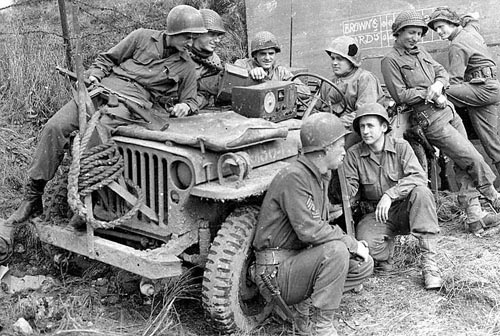 This has quickly become one of my favorite radios. I purchased it on eBay and wasn't sure if it worked or not, but when it arrived, I hooked it up to a variac and an external antenna, and was amazed at the reception and sound of this radio. The top was slightly dented in, which was easily fixed with a sheet metal hammer and a couple pieces of oak. I replaced the scratchy audio gain potentiometer and replaced the electolytic caps and paper caps. Cosmetically, the radio is in pretty good condition for its age. There's a bit of surface rust on exposed metal parts. I used a wire brush in a Dremel tool to remove most of it from the front of the radio. The condition of the paint is good and the lettering is very good, so I cleaned the front gently with alcohol. The top and side were a little more beat up, so I misted a flat black paint over the top and sides just enough to blend with the front. Reception on AM and SW is very good using a 70' long wire antenna.
This has quickly become one of my favorite radios. I purchased it on eBay and wasn't sure if it worked or not, but when it arrived, I hooked it up to a variac and an external antenna, and was amazed at the reception and sound of this radio. The top was slightly dented in, which was easily fixed with a sheet metal hammer and a couple pieces of oak. I replaced the scratchy audio gain potentiometer and replaced the electolytic caps and paper caps. Cosmetically, the radio is in pretty good condition for its age. There's a bit of surface rust on exposed metal parts. I used a wire brush in a Dremel tool to remove most of it from the front of the radio. The condition of the paint is good and the lettering is very good, so I cleaned the front gently with alcohol. The top and side were a little more beat up, so I misted a flat black paint over the top and sides just enough to blend with the front. Reception on AM and SW is very good using a 70' long wire antenna.
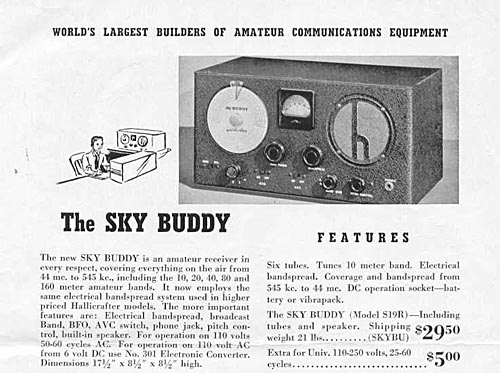
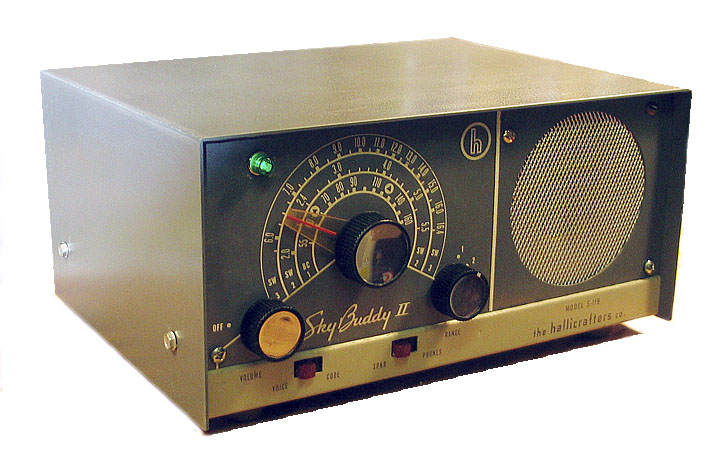
Last in the line of Sky Buddy receivers. The first Sky Buddy, the 5-T was produced in 1935-36, followed by the S-19 in 1938 and S-19R in 1939 (see photo and description below). The model S-119 Sky Buddy II is a three tube receiver, using a selenium rectifier for the power supply. It has three bands, AM broadcast and two shortwave bands covering from about 540 KC to 19 MC. I replaced the eletrolytic caps, but left the selenium rectifier in.
As found, this model was in very poor operating and cosmetic condition. The speaker had been replaced in this radio. The replacement speaker didn't fit quite right and bowed out the front panel. The original speaker grill was discarded and a ugly piece of decorative screen riveted over the front. I removed all that, straightened out the front panel, filled the rivet holes, and repainted the right side, adding a white dividing line. I also tried to match the original paint on the left side and touch up some scratches on the dial scale. I trimmed away some of the bottom of the speaker so it would fit correctly in the opening and re-installed it. I made a new speaker grill from bright aluminum modeling mesh and installed it behind the front panel. I also repainted the top cover as it looked as if it had been hand-painted.
The original red pilot light didn't work, so I replaced that. I only had a green lamp, so that's what I used, but I think it looks ok. The original bottom was missing, and had been replaced with another piece of the same decorative screen that was used for the speaker grill. There were no feet. I made a new bottom and installed rubber feet. As mentioned in an earlier post, the back was broken, so I added a reinforcement strip along the bottom.
I replaced the electrolytic capacitors and the selenium rectifier, which was weak. One tube needed replacement as well. However, I could not get reception on the two shortwave bands. After much trial and error, I discovered someone had modified the wiring in the band selector switch. The modification cut out the two shortwave bands. After restoring the wiring to its original configuration, the radio worked fine.
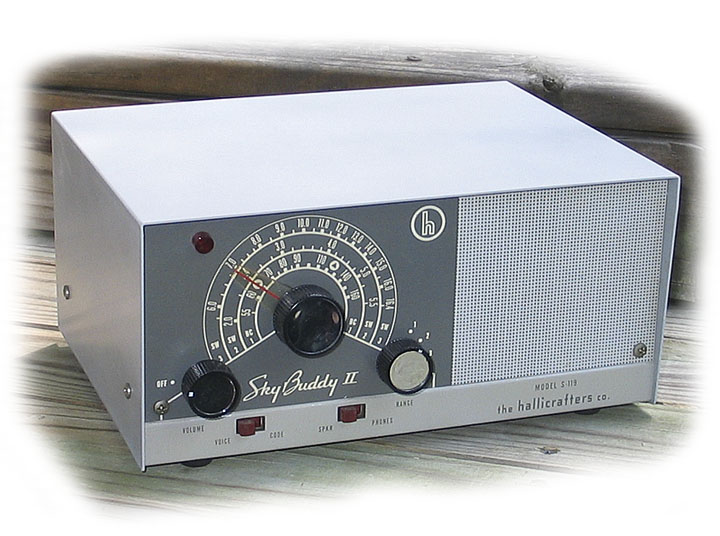
At right is the first Sky Buddy II I restored. As found, this model was in very nice cosmetic condition, the only defect being a rusted top. Although it appears that the knob brights are missing on the left two knobs, it's just an illusion. I sanded the top down to bare metal, primed it, and repainted it. The only electrical restoration required for this radio was to replace the three electrolytic capacitors. All the tubes are original Hallicrafters branded tubes.